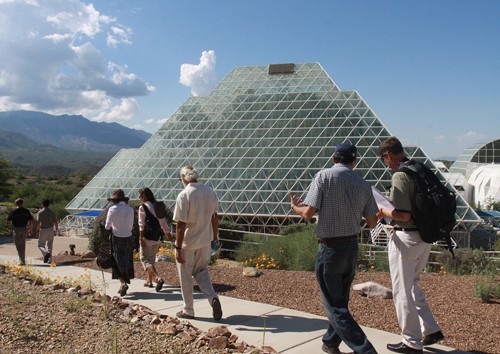The Biosphere was built in 1991 and the original Biosphere experiment lasted until 1993, exploring the interaction between humans and nature, as well as possible techniques that could be applied to space colonization.
The Biosphere is the world’s largest closed biological system. It contains several climates including a savannah, a coastal desert, an ocean, and a tropical rainforest — with distinct flora from each region growing in controlled environments.
The UA took over management of the structure in 2007, transforming it into a science and research facility for students, faculty, and fellows.
The Biosphere is always looking to develop new ways to take advantage of its unique design. Valer Austin of Cuenca Los Ojos, left, and Laurence de Bure, of the Veolia Environmental Foundation, look into the future site of the “”Landscape Evolution Observatory,”” a new area that will allow Biosphere researchers the opportunity to evaluate how soil reacts on a geomorphologic level in newer, more complex ways than are possible now.
Coastal Fog Desert
Sitting at the farthest West point of the facility, the coastal fog desert is modeled after desert on the coast of Baja California. This area features some common desert plants, including Joshua Trees, creosote bushes and Elephant Trees.
Ocean-Savannah
While walking through the Biosphere, tourists can walk along the beach of one of the only oceans in Arizona, all one million gallons of it. In this area known as the ocean-savannah corridor where visitors can simultaneously view two of the most diverse climates in the compound.
Tropical Equatorial Rainforest
One of the most striking areas of the Biosphere is the tropical equatorial rainforest, complete with 60-foot tall trees. “”When most people stand here they can’t believe they’re walking in an area like this in Arizona,”” John Adams, assistant director for Planning and Facilities at the Biosphere 2, said. “”It’s very different from the vegetation one has experienced or seen in the Biosphere up to this point.””
Technosphere
Scott Edwards, of Veolia Water North America, walks through one of the tunnels that comprise the “”technosphere,”” which Adams described as the technical underbelly of the Biosphere.
“”Walking through here gives visitors the opportunity to see where some of the mechanical components that help maintain some of the environments you’ve had the opportunity to walk through,”” he said.
The Lung
Perhaps the most impressive aspect of the Biosphere is the “”lung,”” a 40,000-pound variable volume air chamber that maintains proper air pressure throughout the compound and is itself kept a lot by differences in external and internal air pressures. “”The lung it is really an engineering component that people can’t fathom,”” Adams said. “”It’s like nothing anybody has ever seen.””
“”It is physics at its most ideal and visually appealing component,”” he said.









